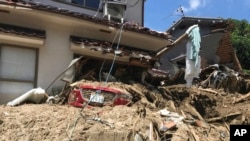The World Meteorological Organization warns the floods, heatwaves and other extreme weather conditions gripping many parts of the world are likely to continue as a consequence of accelerating climate change.
While the world was fixated on the dramatic rescue from a cave in Thailand of 12 boys and their soccer coach, potentially deadly monsoon rains were gathering steam in the region.
The World Meteorological Organization reports extreme weather conditions have dealt a deadly blow in many places, with blistering heatwaves and disastrous precipitation forecast to continue this month.
For example, it notes the recent catastrophic flooding in Japan, the worst in decades, has claimed at least 150 lives. WMO spokeswoman, Claire Nullis, says the death toll is likely to climb. This, in what she calls one of the world’s best prepared countries when it comes to tackling disasters.
“They are supremely well prepared," said Nullis. "And, so the magnitude of the casualties, of the destruction that we are seeing now really is an indication of just how big and how extreme this was and how heavy the rainfall was in such a short period of time.”
Other extreme weather events include drought and abnormally high temperatures in Northern Europe. The WMO expects these conditions to prevail over the coming weeks.
The WMO reports the United States has had the hottest June on record. Nullis notes the Los Angeles area in California continues to hit record high temperatures, such as 48.9 degrees Celsius in the city of Chino.
Elsewhere in the world, she says a city in the Algerian Sahara Desert has reported temperatures of 51.3 degrees Celsius.
“Climate change, as we always say, no specific event can be attributed to climate change, but what we are seeing is consistent with climate change scenarios," said Nullis. "Extreme heat, consistent heat, persistent heat and heavy precipitation.”
WMO scientists say these extreme weather events are compatible with the general long-term trend of global warming caused by the emission of man-made greenhouse gases in the atmosphere.


